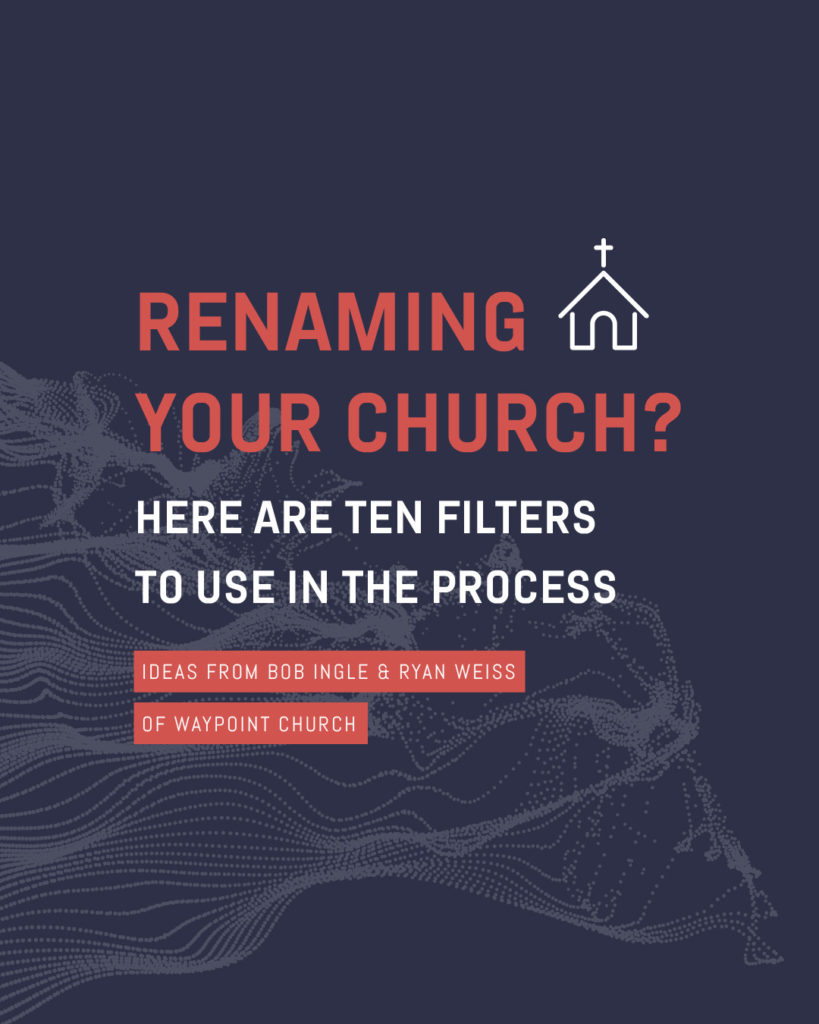
How to Rename Your Church: The Complete Waypoint Story
By: Cory Edwards | Branding Case Studies Church Branding Communications & Marketing Creativity featured Ministry Branding
This “First Baptist Church” renamed their church and inspired a new generation. Here’s how they did it.
Is now the time to rename your church?
If your church has existed for more than a couple of decades, you probably chose its name for an audience that no longer exists. Maybe it’s managed to stay fresh despite the changes in the culture. But do you ever wonder how to rename your church so you can reach more people?
Bob Ingle is the lead pastor of Waypoint Church, a Southern Baptist congregation in the west suburbs of St. Louis. Launched as First Baptist Church of Harvester in 1963, by the time he accepted the position in 2009, he realized their name stood between them and their community.
He thought they should change their name.
But Bob was aware of the pitfalls — that renaming a church can cause difficult emotions, fear, and (worst case scenario) a split!
But he also knew this: Renaming your church can communicate a broader vision, include people who’ve felt excluded, and stir up excitement for the future.
It took nine years of work, but in the end, the congregation was fully on board.
Bob and his team inspire us. Here’s how they:
- Found out if their old name reflected their people’s heart for the future
- Got clarity on the church’s mission and vision
- Helped key leaders understand the “why” behind their need for a new name
- Communicated in a way that reflects the heart of their church
We ran this story in two separate articles and videos last year, but wanted to collect all of this great advice and inspiration in a single place.
>>RELATED PDF DOWNLOAD: Church Renaming Checklist — 10 Filters from Waypoint Church
(FYI, we edited some of the quotes below for clarity and flow.)
1 Consider Renaming Your Church When “the Past Is the Hero”
When Bob joined First Baptist Church of Harvester, he saw a healthy congregation that loved Jesus, gave generously, and enjoyed studying the Bible.
It had a weakness, though. He said the general feeling was: This is what we have always done. This is what we like.
But Bob said, “What I have learned is that, in any church, when the past is the hero, decline is inevitable.”
He recognized this was true at First Baptist Harvester, saying, “They were still holding on to what used to be.” Still, the congregation hadn’t noticed their subtle, but undeniable, decline in numbers.
But he didn’t jump into immediate change. He said, “It took me awhile to find out, ‘Why am I here?’ Because you don’t want to just come in and say, ‘This is what we’re going to do.’
Instead, Bob began asking four questions:
- What is the current vision?
- What do people love?
- What have we held on to that we shouldn’t?
- What has God called us to do?
He continued, “The pastor doesn’t bring a vision to the church. He comes to the church, and then, in the life of the ministry, God reveals what that vision is. It just takes time — and sometimes we don’t want to put in the time.”
2 Rename Your Church After Everyone Understands the Vision — Pastor Included
As Bob started to get an inkling of what God might be leading the church to do, he taught what the Bible says about unity.
“Nothing ever happens when we’re segmented and divided,” Bob said. “The mission of the army has to be the passion of each soldier.”
Next, he taught about the difference between mission and vision. For every church, he believes the mission will always be some wording around The Great Commission.
That will never change.
But a church’s vision statement relates to how an individual church chooses to carry out its mission right now.
To settle on a vision statement, Bob said he first had to understand “who’s part of what God is doing. And then you can understand what the vision is — because you know it’s the people.”
Here’s the pitfall Waypoint avoided: Don’t practice the vision before you understand the people who are part of the vision.
3 Don’t Try to Rename Your Church Until You Communicate the “Why”
Bob joked, “I’ve always been in First Baptist churches. I’m Baptist born, Baptist bred, and when I die, I’ll be Baptist dead.”
But he knew they would need to remove the word “Baptist” from the church’s name starting the moment he arrived in 2009 “because of the direction of our culture.” (More on this later.)
Yet, he was aware that pushing for a name change too early could cause him to lose his job or incite a church split.
After spending years teaching on unity and vision, here’s how he began to suggest they change the name.
Start with the Staff
He started by getting his staff on board, then soliciting their help.
He said, “I wanted the staff to understand the ‘why’ first. People will ask them questions who would never come to me — so we better have essentially the same answers.”
Second, Speak with Your Senior Lay Leadership
Next, Bob went to the Church Council (what they used to call their Board of Elders) and laid everything out for them.
He said it was hard for them to accept a name change at first. But they understood it as they dove into the “why” he had already established with his staff.
And for First Baptist Harvester, in particular, they all knew they had to overcome a “denominational disconnect.”
Here’s what that means.
4 Rename Your Church When the Name Turns People Away
Does the Name of Your Denomination Come with Baggage?
Bob said, “If you’re immersed in Baptist life and culture, you have no idea that ‘real people’ couldn’t care less about your denomination.” In his view, denominational names come with cultural baggage that can keep people out of church and away from Jesus.
Bob says the vast majority of people see the word “Baptist” and think, “I’m not Baptist, so I’m not invited.” The same could apply to any denomination.
Also, younger people didn’t feel especially connected to the word “Baptist.”
Ryan Weiss (their current Communication Director) started on their staff when he was only twenty-one. He said that, from the beginning, what excited him about the church was their vision for the future.
Bob wanted a name that communicated that vision.
Does It Matter that You’re the “First?”
The idea of being the First Baptist Church of Harvester no longer resonated with their congregation either. They couldn’t think of a good reason to communicate to those who had never experienced their church that “We got here first.”
What About Your Town’s Name?
The church’s vision, which by now everyone had bought in on, included being a multisite church. They realized the community name “Harvester” wouldn’t translate to other nearby towns.

Part 2: How to Rename Your Church
Renaming your church is no small decision. But once you’ve decided to rename your church, it’s hard to know where to begin choosing a new name or how to communicate it with the community in a way that gets people
excited
.
After prayerful and intentional engagement with his team, the staff and congregation agreed renaming the church would help them reach more people. Only then did they move forward to select and launch a new name.
Waypoint’s heart and practical approach make a lot of sense to us. They did this right.
Here is what we believe were the keys to their success. Bob and his team:
- Got the “yes” vote to move forward with a name change before choosing a new name
- Involved people in the entire process
- Used ten filters to narrow down name options
- Created swag that would get people excited and connected to the new name
- Constructed a creative and intentional strategy for online engagement
(FYI, we edited some of the quotes below for clarity and flow.)

Ten filters to use when renaming your church
Choosing the right name was necessary; they approached renaming the church both prayerfully and pragmatically.
Bob, Ryan, and the rest of the leadership team wanted to involve the congregation, so they called for name submissions. There were tons of options, and that could have been overwhelming.
But the church applied these ten filters to simplify the process.
1. Are there negative double meanings in name, abbreviations, or nicknames?
2. Is this name already used by another local or well-known church?
“We were
First Baptist Church Harvester
, and there was another large church down the road called
Harvester Christian Church
that was known as ‘Harvester.’ We were often confused for one another.”
3. Is it unique? Are there competing references to well-known companies or brands?
4. Is it limited by location or physical appearance?
5. Is it easy to say and spell?
6. Will end up colloquially abbreviated or shortened?
From Ryan: “We experienced this. ‘First Baptist Church Harvester’ became ‘Harvester’ and then ‘FBCH.’ We lost brand notoriety with those iterations and sent confusing messages to the community because our signs didn’t say either of those.”
7. Will it stand on its own without the word “church”?
“This is where we lost our runner-up name,
Together Church
. We loved the connection to the vision and the branding potential of
Together Church
. But couldn’t get past this sentence: ‘Welcome to Together.’ We would always need to use the word ‘church’ to make that name work.”
8. Are the web domains available?
9. Is it easy to brand?
10. Is there a strong connection to the ministry’s mission, vision, and purpose?
Bob said, “These filters were a game-changer for us. Every name would go down through the filters and CLUNK, hit bottom with an obvious no. We knew right away, ok — that’s not it.”
(Download a PDF of those 10 filters here.)
In the end, there was only one name that got through all ten of their filters: Waypoint Church.
Renaming the church was not about finding something trendy or novel. In the end, it helped them reach more people.
Since First Baptist Church Harvester had been an established congregation for more than fifty years, friends and neighbors were curious about the new name. It gave people a chance to share the message of Jesus.
Bob shared, “I’ve had numerous people say, ‘I’ve shared the gospel more in the last two years with people than I have my whole life.’”
Launch Day: Involve everyone and be intentional
The Waypoint staff wanted to get people excited about the new name and involve everyone in the rollout.
Their communications team created a thoughtful and fun plan that accomplished several goals at once.
SWAG (Stuff We All Get!)
Create and give away things people will be excited about wearing and using. SWAG strategy should not just be about putting your logo on a t-shirt and a pen.
Waypoint was very intentional with every part of this renaming process. The team did not want to spend time, energy, effort, and money creating standard promotional pieces unless people were excited about the items.
They focused on products that were a visual expression of the church and the new vision, something they knew people would be excited and proud to wear.
“The approach was if people are going to be our driving force in promotion, if we can put something beautiful, that is exciting, that is high quality in their hands. If we can put a brand that they can get excited about in their hands, that’s going to be the fuel for those sharing it,” said Ryan Weiss, Waypoint Church’s Communications Director.
Online Engagement
Create opportunities for online engagement that will help you reach practical needs.
Waypoint used the rollout of their new name to help drive engagement on their social channels. At the same time, they established some of the “techy things” they needed for the long run, like their Google searchability — all the way down to the correct pin name in Google Maps.
Renaming the church created momentum for the vision
Renaming Waypoint ultimately set them up to succeed in reaching more people with the gospel. They are now working toward a multi-site strategy and started a game-changer coffee shop.
By changing their name from First Baptist Church Harvester, Waypoint could reach beyond their small suburb, and the word “Baptist” no longer stood between them and non-Baptists. Along with the coffee shop, it’s a signal to the whole community that says, “You can come and hang out here.”
If you’re thinking about renaming your church — or even just renewing your vision — it starts with identifying who you are and who you want to reach. We’ve developed a questionnaire to set you on that path.
